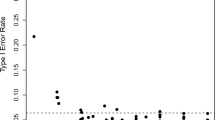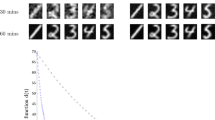Abstract
Importance sampling and Markov chain Monte Carlo methods have been used in exact inference for contingency tables for a long time, however, their performances are not always very satisfactory. In this paper, we propose a stochastic approximation Monte Carlo importance sampling (SAMCIS) method for tackling this problem. SAMCIS is a combination of adaptive Markov chain Monte Carlo and importance sampling, which employs the stochastic approximation Monte Carlo algorithm (Liang et al., J. Am. Stat. Assoc., 102(477):305–320, 2007) to draw samples from an enlarged reference set with a known Markov basis. Compared to the existing importance sampling and Markov chain Monte Carlo methods, SAMCIS has a few advantages, such as fast convergence, ergodicity, and the ability to achieve a desired proportion of valid tables. The numerical results indicate that SAMCIS can outperform the existing importance sampling and Markov chain Monte Carlo methods: It can produce much more accurate estimates in much shorter CPU time than the existing methods, especially for the tables with high degrees of freedom.




Similar content being viewed by others
References
4ti2 team: 4ti2—a software package for algebraic, geometric and combinatorial problems on linear spaces (2006). Available at www.4ti2.de
Agresti, A.: Categorical Data Analysis, 2nd edn. Wiley, New York (2002)
Andrieu, C., Moulines, a., Priouret, P.: Stability of stochastic approximation under verifiable conditions. SIAM J. Control Optim. 44, 283–312 (2005)
Atchadé, Y.F., Liu, J.S.: The Wang-Landau algorithm for Monte Carlo computation in general state spaces. Stat. Sin. 20, 209–233 (2010)
Baglivo, J., Oliver, D., Pagano, M.: Methods for the analysis of contingency tables with large and small cell counts. J. Am. Stat. Assoc. 83, 1006–1013 (1988)
Berg, B.A., Neuhaus, T.: Multicanonical algorithms for first order phase transitions. Phys. Lett. B 267, 249–252 (1991)
Bezáková, I., Bhatnagar, N., Vigoda, E.: Sampling binary contingency tables with a greedy start. In: Proceedings of the 17th Annual ACM-SIAM Symposium on Discrete Algorithm (SODA) (2006)
Bezáková, I., Sinclair, A., Stefankovic, D., Vigoda, E.: Negative examples for sequential importance sampling of binary contingency tables. In: Algorithms ESA 2006. Lecture Notes in Computer Science, vol. 4168, pp. 136–147. Springer, Berlin (2007)
Blanchet, J.H.: Efficient importance sampling for binary contingency tables. Ann. Appl. Probab. 19, 949–982 (2009)
Booth, J.G., Butler, R.W.: An importance sampling algorithm for exact conditional test in log-linear models. Biometrika 86(2), 321–332 (1999)
Bornn, L., Jacob, P.E., Del Moral, P., Doucet, A.: An adaptive interacting Wang-Landau algorithm for automatic density exploration (2012). arXiv:1109.3829
Botev, Z.I., Kroese, D.P.: An efficient algorithm for rate-event probability estimation, combinatorial optimization, and counting. Methodol. Comput. Appl. Probab. 10, 471–505 (2008)
Caffo, B.S., Booth, J.G.: A Markov chain Monte Carlo algorithm for approximating exact conditional probabilities. J. Comput. Graph. Stat. 10(4), 730–745 (2001)
Chen, H.F.: Stochastic Approximation and Its Applications. Kluwer Academic, Dordrecht (2002)
Chen, Y., Diaconis, P., Holmes, S.P., Liu, J.S.: Sequential Monte Carlo methods for statistical analysis of table. J. Am. Stat. Assoc. 100, 109–120 (2005)
Chen, Y., Dinwoodie, I.H., Sullivant, S.: Sequential importance sampling for multiway tables. Ann. Stat. 34, 523–545 (2006)
Chopin, N., Lelievre, T., Stoltz, G.: Free energy methods for Bayesian inference: efficient exploration of univariate Gaussian mixture posteriors. Stat. Comput. 22, 897–916 (2012)
Christensen, R.: Log-liner Models and Logistic Regression, 2nd edn. Springer, New York (1997)
Cox, D., Little, J., O’Shea, D.: Ideals, Varieties and Algorithms. Springer, New York (1992)
Dalenius, P., Reiss, R.S.: Data-swapping: a technique for disclosure control. J. Stat. Plan. Inference 6, 73–85 (1982)
Darve, E., Pohorille, A.: Calculating free energies using average force. J. Chem. Phys. 115, 9169–9183 (2001)
De Loera, J.A., Onn, S.: Markov basis of three-way tables are arbitrarily complicated. J. Symb. Comput. 41, 173–181 (2006)
Del Moral, P., Doucet, A., Jasra, A.: Sequential Monte Carlo samplers. J. R. Stat. Soc. B 68, 411–436 (2006)
Diaconis, P., Sturmfels, B.: Algebraic algorithms for sampling from conditional distributions. Ann. Stat. 26, 363–397 (1998)
Dinwoodie, I.H., Chen, Y.: Sampling large tables with constraints. Stat. Sin. 21, 1591–1609 (2011)
Dobra, A.: Markov bases for decomposable graphical models. Bernoulli 9, 1093–1108 (2003)
Faraway, J.J.: Extending the Linear Model with R. Chapman & Hall, London (2006)
Fort, G., Jourdain, B., Kuhn, E., Lelièvre, T., Stoltz, G.: Convergence and efficiency of the Wang-Landau algorithm (2012). arXiv:1207.6880
Hastings, W.K.: Monte Carlo sampling methods using Markov chains and their applications. Biometrika 57, 97–109 (1970)
Hout, M., Duncan, O.D., Sobel, M.E.: In: Association and Heterogeneity: Structural Models of Similarities and Differences (1987)
Jacob, P.E., Ryder, R.J.: The Wang-Landau algorithm reaches the Flat Histogram criterion in finite time (2011). arXiv:1110.4025
Jerrum, M.R., Sinclair, A., Vigoda, E.: A polynomial-time approximation algorithm for the permanent of a matrix with non-negative entries. J. Assoc. Comput. Mach. 51, 671–697 (2004)
Kuroda, M., Hashiguchi, H., Nakagawa, S.: Computing p-values in conditional independence models for a contingency table. Comput. Stat. 25, 57–70 (2010)
Lauritzen, S.L.: Graphical Models. Clarendon Press, Oxford (1996)
Liang, F.: Dynamically weighted importance sampling in Monte Carlo computation. J. Am. Stat. Assoc. 97, 807–821 (2002)
Liang, F.: Annealing contour Monte Carlo for structure optimization in an off-lattice protein model. J. Chem. Phys. 120, 6756–6763 (2004)
Liang, F.: A generalized Wang-Landau algorithm for Monte Carlo Computation. J. Am. Stat. Assoc. 100, 1311–1327 (2005)
Liang, F.: A theory on flat histogram Monte Carlo methods. J. Stat. Phys. 122, 511–529 (2006)
Liang, F.: On the use of stochastic approximation Monte Carlo for Monte Carlo integration. Stat. Probab. Lett. 79, 581–587 (2009a)
Liang, F.: Improving stochastic approximation Monte Carlo by kernel smoothing: theory and applications. Ann. Stat. 37, 2626–2654 (2009b)
Liang, F.: Trajectory averaging for stochastic approximation MCMC algorithms. Ann. Stat. 38, 2823–2856 (2010)
Liang, F., Liu, C., Carroll, R.: Stochastic approximation in Monte Carlo computation. J. Am. Stat. Assoc. 102(477), 305–320 (2007)
Long, M.A., Berry, K.J., Mielke, P.W.: Multiway contingency tables: Monte Carlo resampling probability values for the chi-squared and likelihood-ratio tests. Psychol. Rep. 107, 501–510 (2010)
Marsili, S., Barducci, A., Chelli, R., Procacci, P., Schettino, V.: Self-healing umbrella sampling: a non-equilibrium approach for quantitative free energy calculations. J. Phys. Chem. B 110, 14011–14013 (2006)
Mehta, C., Patel, N.: A network algorithm for the exact treatment of the 2×K contingency table. Commun. Stat. 9, 649–664 (1980)
Mehta, C., Patel, N., Senchauduri, P.: Importance sampling for estimating exact probabilities in permutational inference. J. Am. Stat. Assoc. 83, 999–1005 (1988)
Metropolis, N., Rosenbluth, A.W., Rosenbluth, M.N., Teller, A.H., Teller, E.: Equations of state calculations by fast computing machines. J. Chem. Phys. 21, 1087–1091 (1953)
Robbins, H., Monro, S.: A stochastic approximation method. Ann. Math. Stat. 22, 400–407 (1951)
Roberts, G.O., Tweedie, R.L.: Geometric convergence and central limit theorems for multidimensional Hastings and Metropolis algorithms. Biometrika 83, 95–110 (1996)
Rubinstein, R.Y., Kroese, D.P.: Simulation and the Monte Carlo Method, 2nd edn. Wiley, New York (2007)
Song, Q., Wu, M., Liang, F.: Weak convergence rate of population stochastic approximation MCMC algorithm. J. Appl. Probab. (2011, under review)
Wang, F., Landau, D.P.: Efficient, multiple-range random walk algorithm to calculate density of states. Phys. Rev. Lett. 86, 2050–2053 (2001)
Whittaker, J.: Graphical Models in Applied Mathematical Statistics. Wiley, New York (1990)
Wu, M., Liang, F.: Population SAMC vs SAMC: convergence and applications to Bayesian model selection problems. J. Biom. Biostat. S1, 002 (2011)
Acknowledgements
The authors thank the editor, associate editor and two referees for their constructive comments which have led to significant improvement of this paper. Cheon’s research was partially supported by Basic Science Research Program through the National Research Foundation of Korea (NRF) funded by the Ministry of Education, Science and Technology (2011-0015000). Liang’s research was partially supported by grants from the National Science Foundation (DMS-1007457 and DMS-1106494) and the award (KUS-C1-016-04) made by King Abdullah University of Science and Technology (KAUST). Chen’s research was partly supported by the National Science Foundation grant DMS-1106796.
Author information
Authors and Affiliations
Corresponding author
Appendices
Appendix A: Markov basis
Let M denote a Poisson log-linear model, as described in Sect. 2, for a contingency table. Let T(M) denote the set of all contingency tables having the marginal totals of the sufficient statistics of model M. Let δ denote a data swapping move (Dalenius and Reiss 1982) of M, in which cell entries are moved from one cell to the other while the marginals of the sufficient statistics of M are left unchanged.
Definition A.1
A Markov basis \(\mathcal{M}\) of the model M is a finite collection of data swapping moves that connect any two tables in T(M). In other words, for any two tables x,y∈T(M), there exists a sequence of data swapping moves \(\boldsymbol{\delta }_{1}, \ldots, \boldsymbol{\delta}_{s} \in\mathcal{M}\) such that
for 1≤s′≤s.
The Markov basis can be computed by finding a Gröbner basis of a well-specified polynomial ideal, which has been implemented in the package 4ti2 (4ti2 team 2006). Although a Markov basis always exists, computing the Markov basis can be very time-consuming or even practically impossible for certain types of models. For example, De Loera and Onn (2006) showed that for the three-way contingency tables with fixed two margins, the Markov basis can contain entries of arbitrarily large size.
Appendix B: Contingency tables of examples
Rights and permissions
About this article
Cite this article
Cheon, S., Liang, F., Chen, Y. et al. Stochastic approximation Monte Carlo importance sampling for approximating exact conditional probabilities. Stat Comput 24, 505–520 (2014). https://doi.org/10.1007/s11222-013-9384-6
Received:
Accepted:
Published:
Issue Date:
DOI: https://doi.org/10.1007/s11222-013-9384-6




